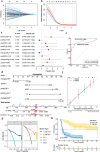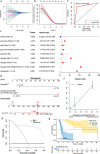New biomarkers exploration and nomogram construction of prognostic and immune-related adverse events of advanced non-small cell lung cancer patients receiving immune checkpoint inhibitors
- PMID: 36849947
- PMCID: PMC9972722
- DOI: 10.1186/s12931-023-02370-0
New biomarkers exploration and nomogram construction of prognostic and immune-related adverse events of advanced non-small cell lung cancer patients receiving immune checkpoint inhibitors
Abstract
Background: Immune checkpoint inhibitors (ICIs) are regarded as the most promising treatment for advanced-stage non-small cell lung cancer (aNSCLC). Unfortunately, there has been no unified accuracy biomarkers and systematic model specifically identified for prognostic and severe immune-related adverse events (irAEs). Our goal was to discover new biomarkers and develop a publicly accessible method of identifying patients who may maximize benefit from ICIs.
Methods: This retrospective study enrolled 138 aNSCLC patients receiving ICIs treatment. Progression-free survival (PFS) and severe irAEs were end-points. Data of demographic features, severe irAEs, and peripheral blood inflammatory-nutritional and immune indices before and after 1 or 2 cycles of ICIs were collected. Independent factors were selected by least absolute shrinkage and selection operator (LASSO) combined with multivariate analysis, and incorporated into nomogram construction. Internal validation was performed by applying area under curve (AUC), calibration plots, and decision curve.
Results: Three nomograms with great predictive accuracy and discriminatory power were constructed in this study. Among them, two nomograms based on combined inflammatory-nutritional biomarkers were constructed for PFS (1 year-PFS and 2 year-PFS) and severe irAEs respectively, and one nomogram was constructed for 1 year-PFS based on immune indices. ESCLL nomogram (based on ECOG PS, preSII, changeCAR, changeLYM and postLDH) was constructed to assess PFS (1-, 2-year-AUC = 0.893 [95% CI 0.837-0.950], 0.828 [95% CI 0.721-0.935]). AdNLA nomogram (based on age, change-dNLR, changeLMR and postALI) was constructed to predict the risk of severe irAEs (AUC = 0.762 [95% CI 0.670-0.854]). NKT-B nomogram (based on change-CD3+CD56+CD16+NKT-like cells and change-B cells) was constructed to assess PFS (1-year-AUC = 0.872 [95% CI 0.764-0.965]). Although immune indices could not be modeled for severe irAEs prediction due to limited data, we were the first to find CD3+CD56+CD16+NKT-like cells were not only correlated with PFS but also associated with severe irAEs, which have not been reported in the study of aNSCLC-ICIs. Furthermore, our study also discovered higher change-CD4+/CD8+ ratio was significantly associated with severe irAEs.
Conclusions: These three new nomograms proceeded from non-invasive and straightforward peripheral blood data may be useful for decisions-making. CD3+CD56+CD16+NKT-like cells were first discovered to be an important biomarker for treatment and severe irAEs, and play a vital role in distinguishing the therapy response and serious toxicity of ICIs.
Keywords: Adverse events; Biomarkers; Immune; Lung cancer; Nomogram.
© 2023. The Author(s).
Conflict of interest statement
The authors declare that the research was conducted in the absence of any commercial or financial relationships that could be construed as a potential conflict of interest.
Figures





Similar articles
-
Two nomograms constructed for predicting the efficacy and prognosis of advanced non‑small cell lung cancer patients treated with anti‑PD‑1 inhibitors based on the absolute counts of lymphocyte subsets.Cancer Immunol Immunother. 2024 Jun 4;73(8):152. doi: 10.1007/s00262-024-03738-x. Cancer Immunol Immunother. 2024. PMID: 38833153 Free PMC article.
-
Habitat radiomics analysis for progression free survival and immune-related adverse reaction prediction in non-small cell lung cancer treated by immunotherapy.J Transl Med. 2025 Apr 3;23(1):393. doi: 10.1186/s12967-024-06057-y. J Transl Med. 2025. PMID: 40181378 Free PMC article.
-
Identification of prognostic factors and nomogram model for patients with advanced lung cancer receiving immune checkpoint inhibitors.PeerJ. 2022 Dec 15;10:e14566. doi: 10.7717/peerj.14566. eCollection 2022. PeerJ. 2022. PMID: 36540802 Free PMC article.
-
Patients with melanoma treated with immune checkpoint inhibitors who had non-thyroid endocrine and skin immune-related adverse events have better prognosis: A systematic review and meta-analysis.Front Oncol. 2022 Sep 14;12:976224. doi: 10.3389/fonc.2022.976224. eCollection 2022. Front Oncol. 2022. PMID: 36185176 Free PMC article.
-
Risk factors for adverse events induced by immune checkpoint inhibitors in patients with non-small-cell lung cancer: a systematic review and meta-analysis.Cancer Immunol Immunother. 2021 Nov;70(11):3069-3080. doi: 10.1007/s00262-021-02996-3. Epub 2021 Jun 30. Cancer Immunol Immunother. 2021. PMID: 34195862 Free PMC article.
Cited by
-
Neutrophil to Lymphocyte ratio as a predictor for immune-related adverse events in cancer patients treated with immune checkpoint inhibitors: a systematic review and meta-analysis.Front Immunol. 2023 Aug 9;14:1234142. doi: 10.3389/fimmu.2023.1234142. eCollection 2023. Front Immunol. 2023. PMID: 37622124 Free PMC article.
-
Development of a lung immune prognostic index-based nomogram model for predicting overall survival and immune-related adverse events in non-small cell lung cancer patients treated with sintilimab.Front Immunol. 2025 May 8;16:1569689. doi: 10.3389/fimmu.2025.1569689. eCollection 2025. Front Immunol. 2025. PMID: 40406139 Free PMC article.
-
The effects of postoperative targeted immunotherapy on peripheral blood cytokines and immune cell profile in lung cancer patients.Front Oncol. 2024 Jun 5;14:1342624. doi: 10.3389/fonc.2024.1342624. eCollection 2024. Front Oncol. 2024. PMID: 38903721 Free PMC article.
-
Risk factors associated with immune-related severe adverse events in patients with cancer: A scoping review.Asia Pac J Oncol Nurs. 2025 Feb 7;12:100661. doi: 10.1016/j.apjon.2025.100661. eCollection 2025 Dec. Asia Pac J Oncol Nurs. 2025. PMID: 40062359 Free PMC article. Review.
-
Myocarditis prediction in locally advanced or metastatic lung cancer patients with cardiac parameters abnormalities undergoing immunotherapy: development and validation of a risk assessment model.BMC Cancer. 2025 Mar 25;25(1):541. doi: 10.1186/s12885-025-13943-1. BMC Cancer. 2025. PMID: 40133887 Free PMC article.
References
MeSH terms
Substances
Grants and funding
LinkOut - more resources
Full Text Sources
Medical
Research Materials

